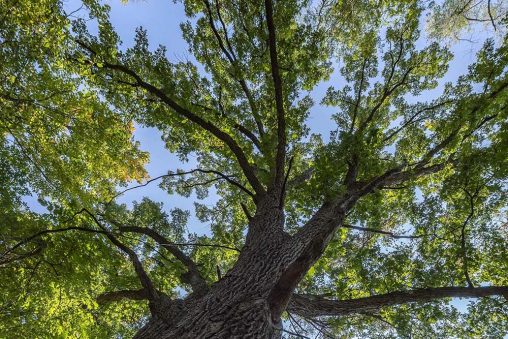
“Burly,” a bur oak, is the largest tree in the Wright State woods and estimated to be about two centuries old.
The ever-changing forest, conservation of archaeological sites, the water quality of streams and recreational activities in the woods are among the topics that will be explored during the fourth annual Wright State University Runkle Woods Symposium.
The Runkle Woods Symposium will be offered both in-person and online on Friday, Nov. 19, from 1 to 5 p.m., in 101 Fawcett Hall and streaming on Webex. The event is open to students, faculty and staff.
The livestream of the symposium will also be recorded and available on CORE Scholar.
The annual Runkle Woods Symposium is an opportunity to explore the Wright State woods with faculty, staff and students from the College of Science and Mathematics and the College of Liberal Arts who are involved in research and creative projects in the woods.
Whitney White, a student involved in conservation biology, is part of a group that will give a presentation on its efforts to help keep the woods clean.
“The symposium is important because it gives students an inside look at all of the research we can do right in our backyard,” said White. “I’ve had classes where we collected data in the woods. It’s much more meaningful when you get to apply the things you learn in class to a real-world system like our woods.”
The symposium is named after James Runkle, Ph.D., professor emeritus of biological sciences. Runkle will give this year’s keynote address on “Personal perspectives on the ever-changing WSU woods.”
The Wright State University woods is 225 acres of forest that is home to up to 110 species of birds as well as foxes, coyotes, deer, salamanders and the rare Indiana bat.
Runkle Woods Symposium schedule:
1–1:15 p.m.: “Introductory remarks,” Volker Bahn, Ph.D., associate professor of biological sciences
1:15–1:45 p.m.: “Personal perspectives on the ever-changing WSU woods,” James Runkle, Ph.D., professor emeritus of biological sciences
1:45–2 p.m.: “We can do Campus Recreation in The Woods!” Erin Sherrets, Outdoor Recreation program manager
2– 2:15 p.m.: “The Role of the WSU Woods in Army ROTC Training,” Edward Wittig and Caleb Matos, ROTC
2:15–2:30 p.m.: “Conservation of Archaeological Sites in the Wright State University Woods,” Lance Green, Ph.D., associate professor anthropology
2:30–2:45 p.m.: “Water quality issues in the streams in the WSU Woods: an update,” Audrey McGowin, Ph.D., professor and interim chair of chemistry
2:45–3:15 p.m.: Break
3:15–3:30 p.m.: “Biodiversity of the Wright State Woods through the seasons,” Don Cipollini, Ph.D., profess of biological sciences and director of environmental sciences
3:30–3:45 p.m.: “The Colonization of invasive shrubs by native caterpillars,” John Stireman, Ph.D., profess of biological sciences
3:45–4 p.m.: “Autumn bees of the WSU prairie,” Adam Foster, biological sciences students
4–4:10 p.m.: “Honeysuckle management,” Matt Rusk, Rachel Seyler, Callie Owens and Mariah Slaughter, biological sciences students
4:10–4:20 p.m.: “Cleaning up the Wright State Woods,” Whitney White, Paige Dunham, Danielle Potter and Will Wiseman, biological sciences students
4:20–4:30 p.m.: “Invasive species inventory with focus on honeysuckle,”, Matt Magill, Sierra Walker, Paige Parrish and Victoria Fliehman, biological sciences students
4:30–4:40 p.m.: “Public education for conservation of the Wright State Woods,” Kristen Steinke, earth and environmental sciences student, and Ellie Fisk, Brandon Calvert and Carley Elliot, biological sciences students
4:40–5 p.m.: “’Being’ in the Woods,” Marie Thompson, Ph.D., associate professor of communication

 Wright State psychology team studies ways to identify fatigue in pilots, drivers
Wright State psychology team studies ways to identify fatigue in pilots, drivers  Wright State videographer Kris Sproles wins Regional Emmy and Ohio journalism award
Wright State videographer Kris Sproles wins Regional Emmy and Ohio journalism award  Wright State Boonshoft School of Medicine ranked among the nation’s best for 2024 by U.S. News
Wright State Boonshoft School of Medicine ranked among the nation’s best for 2024 by U.S. News  Exposing biotechnology
Exposing biotechnology  Wright State faculty member Dan Noel uses unique background to inspire new leaders
Wright State faculty member Dan Noel uses unique background to inspire new leaders 